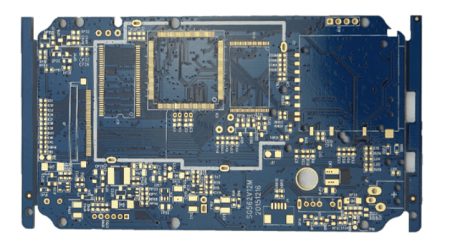Printed circuit board, PCB for short is a substrate for assembling electronic parts. It is a printed circuit board that connects points and prints components on a common base material according to a predetermined design. The main function of the product is to make various electronic components form a predetermined circuit connection, play the role of relay transmission, and is the key electronic interconnection of electronic products. The manufacturing quality of printed circuit boards not only directly affects the reliability of electronic products, but also affects the overall competitiveness of system products. Therefore, printed circuit boards are called “the mother of electronic system products.” The development level of the printed circuit board industry can reflect a certain extent the development speed and technical level of the electronics industry in a country or region.
Fiberglass Cloth: It is one of the raw materials for copper clad laminates. It is woven from fiberglass yarn and accounts for about 40% (thick board) and 25% (thin board) of the cost of the copper clad laminate. Glass fiber cloth manufacturing is similar to weaving companies. The production capacity and quality can be controlled by controlling the speed, and the specifications are relatively single and stable. There has been almost no major change in specifications since World War II. Unlike CCL, the price of fiberglass cloth is most affected by the relationship between supply and demand. In recent years, the price has fluctuated between US$0.50 and US$1.00 per meter. At present, the production capacity of Taiwan and Mainland China accounts for about 70% of the global production capacity. The relationship between upstream and downstream is the key to the operation. The price of a loom is 100,000 to 150,000. Generally, more than 100 units can be produced normally. However, the subsequent heat treatment and chemical treatment equipment require higher funds, reaching tens of millions. The production capacity expansion of cloth is easy and flexible.

Copper Foil: Copper foil is the raw material that accounts for the largest proportion of the cost of copper clad laminates, accounting for about 30% (thick plate) and 50% (thin plate) of the cost of copper clad laminates. Therefore, the price increase of copper foil is the main driving force for the price increase of copper clad laminates. Copper foil is widely used, not only in the copper clad laminate industry. When the copper clad laminate industry is in a downturn, copper foil manufacturers can switch to copper foil for other purposes. The price of copper foil is closely reflected in the price change of copper. As the price of copper continues to rise, copper foil manufacturers are shifting cost pressure to the downstream. The high-tech barriers in the copper foil industry have led to insufficient domestic supply. High-grade copper foil still needs to be imported in large quantities, and the cost of investment in setting up factories is also very high.
Copper Clad Laminate (CCL for short): It is based on electronic grade glass fiber cloth, impregnated with epoxy resin, and after drying treatment, it is made into a semi-cured bonding sheet, and then stick a thin sheet of copper foil on the single-sided, double-sided or multi-layer board. Manufactured under special hot pressing process conditions, it is the direct raw material of PCB. The copper clad laminate industry has a large demand for funds, with a small-scale factory of about 50 million yuan, a high degree of concentration, and there are about 100 in the country. The copper clad laminate industry is a cost-driven cyclical industry. In the upstream and downstream industry chain structure, CCL has strong bargaining power for PCBs. As long as downstream demand is sufficient, the pressure of rising costs can be passed on to downstream PCB manufacturers, but only with a large scale. CCL can have a strong voice in the procurement of raw materials such as fiberglass cloth and copper foil. Due to the single use of copper clad laminate products, they can only be sold to printed circuit board manufacturers. When the PCB is in a downturn, the price can only be lowered to ensure the utilization of production capacity.
PCB: Compared with the upstream and downstream industries, the characteristics of the printed circuit board industry determine that its industry concentration is not high; in the fierce market competition environment, only those companies with good market positioning and high operating efficiency can have long-term competitiveness. The PCB production line needs more than 20 million yuan, the multilayer board needs 50 million yuan, and the HDI needs more than 200 million yuan. Due to the huge industry, the division of labor is very fine, there is a single-station outsourcing specializing in drilling and other processes, and the supply of low-end products exceeds demand. HDI and other high-end printed circuit board industries are capital and labor-intensive industries, and require relatively high management and technology, which often become a bottleneck for capacity expansion.














XPCB Limited is a premium PCB & PCBA manufacturer based in China.
We specialize in multilayer flexible circuits, rigid-flex PCB, HDI PCB, and Rogers PCB.
Quick-turn PCB prototyping is our specialty. Demanding project is our advantage.
Tel : +86-136-3163-3671
Fax : +86-755-2301 2705
Email : info@x-pcb.com
© 2024 - XPCB Limited All Right Reserve